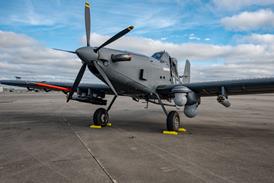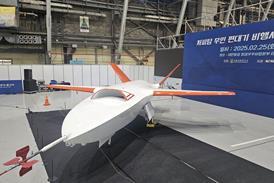Suddenly, however, the odds have shortened. By the end of the year, three of the world's leading carriers - Singapore Airlines, Swissair and British Airways - plan to start testing new in-flight video systems, including software for such casino favourites as blackjack and poker.
A swipe of a credit card - and later, perhaps, the swipe of a frequent flyer card which allows the gambler to stake mileage points instead of money - will pitch a passenger in search of the betting buzz against the computer. Proponents claim, the losers will at least help to mitigate against the high installation and operating costs of the whole entire IFE system. 'The commercial aviation industry is poised at the doorstep of an era in in-flight gaming that could pay for, or at least significantly offset, the high cost of installing interactive entertainment systems,' says Gordon Stevenson, managing director of Memphis-based Interactive Entertainment Limited (IEL), a joint venture between Sky Games International and Harrah's Entertainment. In April, IEL announced an exclusive agreement to provide gaming software and operational services to SIA.
But whether in-flight gaming will deliver all the promises of the manufacturers - in particular, the windfall for airlines - has yet to be seen. The technology is new, consumer acceptance is speculative, video system and software costs are high, and government restrictions are rife. Nonetheless, even smaller airlines are starting to show an interest in in-flight gambling systems. Spanish charter carrier Oasis International Airlines and UK startup Debonair Airlines have signed up with Las Vegas-based Interactive Flight Technologies (IFT) to supply IFE systems that include gambling software.
Published estimates of installation costs for an interactive entertainment system run a broad spectrum, from $1.5 million to more than $4 million for a widebody aircraft. Based on current prices, fuel burn from the added weight of the systems could push expenses up another $450,000 annually on a B747-400, according to US Federal Aviation Administration figures. The system also takes up valuable belly cargo capacity.
Stevenson, however, suggests that a B747-400 could produce between $600,000 and $1.5 million in gambling revenue per year, depending on such factors as the limit on losses an airline places on a gambling passenger. He bases his calculation on the assumption that in-flight gambling will achieve a 15 per cent 'passenger penetration' - a recent DOT study suggests 18 per cent of all US transatlantic and transpacific travellers would gamble if they were offered the opportunity.
The problem is that no precedent exists on which to base such projections. Stevenson points to a study commissioned by IEL that estimates that up to 600 long-haul, widebody aircraft will be equipped with in-seat video monitors by 2000, even though only a handful of carriers are testing or planning to test fully interactive systems that actually include gaming.
This has not stopped the producers of gambling software and the interactive systems that support it from making the potential gains of a gaming device one of the main selling points. And, similarly, the airlines' in-flight product managers also appear to be relying on unquantifiable gambling losses by their passengers to justify the purchase of such sophisticated and expensive entertainment systems to their boards.
Swissair's order with IFT is the sort of deal more airlines are likely to seek, while this kind of technology is in its infancy. The $70-80 million contract will see the manufacturer fit out 16 MD-11s and five B747-300s with an entertainment system that would provide each seat with video on demand and casino-style gambling.
IFT will initially be paid by revenue generated by gambling and will eventually operate the system under a management contract. But to underline the Swiss carrier's doubts over the viability of the product, the deal would never have been done if IFT had not provided a guarantee for the gambling system's revenue stream. According to the newsletter In-Flight Entertainment International, Swissair's scepticism led the board to insist on IFT securing a $100 million bond in case revenues from the system do not meet projections.
Virgin Atlantic Airways has taken this scepticism one step further. Lysette Gauna, manager of the carrier's in-flight services, says that any gambling system that Virgin will eventually offer will be only be aimed at entertaining its customers, not defraying installation costs. The airline has already suffered a two-year delay in putting a gaming feature on-line, primarily due to its problem-plagued interactive entertainment system that was first installed in 1992. Other concerns voiced in the industry range from a general lack of interest in gambling to the potential public relations damage of a passenger suffering massive losses. Indeed, both Cathay Pacific and SAS have already rejected in-flight gambling, citing incompatibility with their images.
Concerns about uncontrolled losses have driven airlines and software providers to put in place loss limits on in-flight video gambling. BA's system, for instance, will limit losses to roughly $100 in economy, while business class and first class passengers will have a cap of double that amount.
Some airline officials have talked about limits significantly lower than that, while Stevenson points to the limits that Mastercard put on its in-flight commerce category, which the credit card company introduced in September. At the bottom end this limited losses to $350, while putting a $3,500 ceiling on wins, which 'protects passengers while not inhibiting them.'
In the US, the potential of passenger losses is seen as one of the many reasons why video gambling must be regulated. Airlines and technology providers lament this decision, but how the US can resolve this problem once and for all remains to be seen. The most obvious solution - to permit in-flight gambling on all carriers outside US airspace - appears too controversial for serious consideration at present.
But US cruise ships have used this dispensation since 1992 and can open up their gaming tables once they reach international waters. For Virgin Atlantic, not even considering such a basic solution typifies a hardheaded recalcitrance on the part of US policy makers that has helped to engender a debate over 'extraterritorial reach.' 'It is such an arrogant stance,' says Gauna, 'it is really absurd.'
Arrogant, absurd or both, DOT officials in Washington seriously doubt there will be significant changes in attitudes toward in-flight gaming any time soon on Capitol Hill. The 1962 law that banned US airlines from offering gambling on either domestic or international flying was buttressed by further legislation in August 1994 that banned in-flight gambling on foreign carriers serving the US. Though the amendment was drawn up to protect US carriers which were already barred from offering gambling, the regulation also came at a time when public attitudes towards the gambling industry were beginning to change.
Less than a decade into a gaming boom that has seen casinos appear in 28 states, the US has begun to take stock of the social ills that accompany such a pastime. Stories of a wave of compulsive gambling (a reported $40 billion in gambling losses was run up in the US in 1994) have recently been eclipsed by tales of gaming industry-related political corruption and graft in the southern states of Louisiana and Mississippi. 'Gambling is a much larger social issue in the current environment,' says a transportation department official. 'It's a hot-button topic. [With in-flight gaming] you have to understand the context.'
The anti-gambling fervour has gained momentum because it is presidential election year in the US, but the fallout is set to last far beyond November's election. The current rhetoric is responsible for the imminent creation of a National Gambling Commission that will study all facets of gambling's impact on US society, including, no doubt, in-flight gaming. The panel will have a two-year tenure and was close to being established by Congress in late May.
As the US represents 40 per cent of the world's air travel market, the country is an important part of many international airlines' operating strategies. Still, non-US airlines are proceeding with installing gambling systems without access to that customer core. Certainly, carriers like BA, Virgin and Swissair are hoping circumstances will change. In the end it could only be a matter of time before competitive disadvantages force US airlines to push for changes in the US law.
Legislative changes could come sooner. The International Airline Coalition on the Rule of Law, a group of 11 non-US carriers, complained last year that forcing US gambling restrictions on non-US airlines is a violation of international law and far exceeds US jurisdiction. US DOT officials note that most countries have built-in dispute resolution clauses in their aviation bilaterals with the US, which could form the basis of a complaint by an aggrieved non-US carrier to their own government.
One carrier, however, is not inclined to submit to bureaucratic whim. Virgin Atlantic has hinted that once it gets its gaming system operational, the US may have to deal with an outlaw testing the gaming restrictions. 'When the systems are ready, the issue will be forced,' says Gauna. 'It will take a maverick airline to push it.'
US carriers like United Airlines, TWA and Northwest Airlines have considered the installation of video gaming. They may be convinced by the tests that are starting this year in other parts of the world that in-flight gambling systems are needed on their own aircraft. A DOT study on IFE systems has already drawn some tempting conclusions: 'We estimate that if US airlines were permitted to offer video gambling on international flights, they would realise gross revenues of $300 million while incurring related operating expenses of $75 million, leaving their gambling revenues at approximately $225 million per year.' These figures represent an average of two quantification methods, one based on average gross take in terms of traffic in the transpacific and transatlantic markets, the other based on number of aircraft flying, with the assumption that revenue potential for video gambling on a single aircraft is $1 million annually.
Given such a significant amount of suspected revenue, US officials concede that the adverse competitive impact on US airlines not permitted to offer gambling 'is potentially quite significant.' However, the same survey concludes that passengers not given the option to gamble during international flights were equally, if not more satisfied, than those with the option.
This suggests that in-flight gambling will not become such a make-or-break issue for airlines and in-flight gaming vendors may be better served stressing the fun side of the gambling option. Though profits can depend on capturing the incremental passenger, there is relatively little evidence to suggest that airlines with gambling will win over a significant number of travellers from those carriers that do not offer it. 'We're certainly not saying the passenger chooses because [of the possibility] of winning a couple of pounds,' says Gauna. 'It is just fun.'
Source: Airline Business























